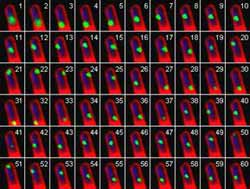Researchers succeed in observing for the first time how DNA damage is identified in living cells

Protein (green dot) shown in this sequence scanning through a cell’s DNA for mutations.
The research sheds new light on understanding this molecular mechanism and is likely to aid in research on diseases involving DNA damage, including cancer.
An article regarding the work of the Hebrew University researchers appears in the current issue of the scientific journal Cell.
The researchers, headed by Dr. Sigal Ben-Yehuda of the Department of Molecular Biology at the Hebrew University-Hadassah Medical School, revealed a new protein which scans DNA at the onset of bacterial sporulation. The protein moves quickly along the chromosome and identifies DNA damage. When the protein identifies such damage, it halts at that spot and signals to other proteins which repair DNA.
Under conditions of stress, some bacteria undergo a process of division which produces spores. These spores are particularly resistant to conditions of heat, radiation, dryness and exposure to chemicals, making it difficult to eradicate them with conventional methods, such as antibiotic drugs.
Most of the knowledge about sporulation of bacteria has been gathered over the years on a bacterium known as Bacillus subtilis, a bacterium which does not cause any illnesses. When this bacterium enters the sporulation phase, it verifies that the DNA sequence is in proper order and does not contain any mutations. But the process of how this occurs has not been observed until now.
“For the first time it is now possible to see how this phenomenon occurs,” said Dr. Ben-Yehuda. “Proteins triggered by the bacteria that are similar to the protein that has been revealed in our laboratory are found in all species, including humans, and therefore one can conclude that the way in which the bacterial protein scans the DNA for lesions is similar among many forms of life.
“This understanding of the molecular basis of the DNA repair is a basic step in furthering our ability to understand those illnesses stemming from DNA damage, for example cancerous growths. “
Media Contact
More Information:
http://www.huji.ac.il/huji/eng/All latest news from the category: Life Sciences and Chemistry
Articles and reports from the Life Sciences and chemistry area deal with applied and basic research into modern biology, chemistry and human medicine.
Valuable information can be found on a range of life sciences fields including bacteriology, biochemistry, bionics, bioinformatics, biophysics, biotechnology, genetics, geobotany, human biology, marine biology, microbiology, molecular biology, cellular biology, zoology, bioinorganic chemistry, microchemistry and environmental chemistry.
Newest articles

Superradiant atoms could push the boundaries of how precisely time can be measured
Superradiant atoms can help us measure time more precisely than ever. In a new study, researchers from the University of Copenhagen present a new method for measuring the time interval,…

Ion thermoelectric conversion devices for near room temperature
The electrode sheet of the thermoelectric device consists of ionic hydrogel, which is sandwiched between the electrodes to form, and the Prussian blue on the electrode undergoes a redox reaction…

Zap Energy achieves 37-million-degree temperatures in a compact device
New publication reports record electron temperatures for a small-scale, sheared-flow-stabilized Z-pinch fusion device. In the nine decades since humans first produced fusion reactions, only a few fusion technologies have demonstrated…





















